
by Claire Anne Brule | May 13, 2022 | Digital identity, News

Digital identity is a tool used to codify the unique attributes of an individual, while digital technology enables a person to prove his identity. There are 3 different categories of digital identity: declarative, calculated, and acting identity. The declarative identity is what the user declares about himself, such as a username and password used when subscribing to on-line applications and which can be modified. There is also what the others can see and deduct from someone’s digital interactions. This is the calculated identity, which uses algorithms automatically generated by the system (number of friends, groups, messages…), and the acting identity which builds a profile of the person based on his connections, and his clicks… Digital identity can recognize a person in what is most specific an unique to her, and can prove this identity using digital technology.
Digital Identity Guarantee Service (“SGIN”)
The French government has just signed a decree authorizing the creation of a “Digital Identity Guarantee Service (SGIN), currently presented as free and not compulsory. This decree also formally put an end to a former project to create on line identification on mobiles, the Alicem project, which had been tested since June 2019 and was based on facial recognition tools.
The new service claims it will facilitate digital life on a daily basis, enabling citizens to authenticate their identity in a secure manner with a single digital tool.
The SGIN is inserted in the chip of the new French electronic ID cards (CNIe) used since August 2nd 2021. The chip contains two types of data: civil registration and biometrics (photograph and fingerprints), and the digital identity program which only contains civil registration data without biometrics (photo and fingerprints).
The application is presented on the website France digital identity, and a test version will be available this month. The user’s identity is verified via his smartphone and the data from his digital national identity card (CNIe) and the identity proof is generated. In France, the regulator of personal data is known as the National Commission for Information Technology and Civil Liberties or the “CNIL”. Previously, the CNIL was wary about Alicem, but last December the commission gave its approval to the new SGIN project, but stressed that it should not be compulsory, and should be user-friendly “for the general public, including those unfamiliar with digital technology”. The commission also pointed out that, unlike Alicem, the application does not make it necessary to record more information than the one used to create an identity card.
Facial Recognition and Gabor’s Law
At the same time, the Senate’s Law Commission recently released a report on “biometric recognition in public areas”. Technological developments and AI in particular have contributed to the on-going spread of facial recognition technology. According to the report “there are many issues raised by the use of facial recognition”. These issues are dealing with “two interdependent topics: civil liberties and France’s digital sovereignty”.
Digital technology facilitates storing, analyzing, centralizing, and transmitting data on a massive scale. Nonetheless, this technology does not guarantee that data will not be leaked, lost or hacked. Nor does it guarantee that the data will not be used in ways that jeopardize individual freedom and private life.
As a leader in facial recognition, China’s use of AI to control the population is regularly mentioned in the media, especially in the context of its’ social credit“ system, reminiscent of George Orwell’s fictional character “Big Brother”, in his dystopian novel, “1984”.
To “avoid the risk of being under constant surveillance”, the Senate’s Law Commission has proposed 4 bans:
- No social ratings,
- No categorization of individuals (according to sex, opinions, ethnic origin…),
- No emotion analytics,
- No real-time remote biometric monitoring
This Commission has also indicated 3 principles to be upheld: subsidiarity, systematic controls carried out by humans, and transparency. These 3 principles combined with the 4 bans set the “red lines” to protect against the risk of turning into a surveillance society. Regulated experimental methods would be used to “debate and define how biometric recognition is to be used” and would include input from the public and independent assessments. Information will be published for the general public to provide a better understanding of the issues. A third set of propositions in the report states that the “red lines” and the supervising experimental methodology are to be controlled a priori and a posteriori. In theory, this sets limits to the State in its’ use of technology to control people. In an interview, the bill’s rapporteur Marc-Philippe Daubresse compares the red lines not to be crossed for facial recognition to “the red lines set for bioethics“. Indeed, the parallel with bioethics can be observed in the report’s summary on pages 2 and 3.
Thus, regarding the ban on categorization, there is an exception which says “except for scientific research and subject to appropriate safeguards”. Likewise, emotion analytics would be allowed “for health or scientific research purposes and subject to appropriate safeguards”. Finally, the ban on “real-time remote biometric surveillance in public areas” includes a clause specifying it would be allowable “with very limited exceptions for the benefit of security forces”; in particular “during demonstrations on a public thoroughfare and in the vicinity of places of worship”.
Although “Gabor’s law” is only an adage and not an inevitable physical law, it states that “if it’s technically feasible, it will necessarily be done”. In bioethics and politics, as well as in many other fields, a solid reasoning on the limits to be set is urgently needed.

by Claire Anne Brule | May 6, 2022 | News, Surrogacy

Ukraine is an international surrogacy hub, and one of the few countries that legally allows foreign customers to enter into commercial surrogacy arrangements. In recent years, this business has flourished due to the low-cost rates, even attracting foreigners from countries where surrogacy is tolerated. Due to economic hardships and precarious situations, more and more Ukrainian women have resorted to this reproductive exploitation, already accounting for 2000 to 2500 surrogacies every year.
The global pandemic, followed by the war, have brought to light surrogacy’s inextricable injustices. When a surrogate mother signs a contract, she surrenders her freedom, giving the sponsors and the agency full control over her life and her body. The Ukrainian surrogacy business has recently been disrupted by the tragic civilian displacement coupled with a break-down in services at the birth registration office. The legal tricks used by the sponsors to conduct their paid gestational surrogacy being undermined, they have to resort to other means to get their surrogate baby.
It is estimated that two babies are born every week in Ukraine for French clients.
Lately some investigations, including one published by Le Figaro, have reported the arrival of Ukrainian surrogate mothers in France. Katarina, for example, arrived alone in March, without her two girls aged 3 and 10, whom she was forced to leave behind with their grandmother. So far, two “surrogate babies” have already been born on French territory, one in the region of Lyon and the other one in Vendée.
Despite the fact that surrogacy is prohibited in France, French sponsors bypass the law by bringing their surrogate mother to France and having her give birth anonymously (“sous X” meaning under X in the place of their biological mother). The man who has provided his gametes for conception then proceeds to be recognized as the biological father and claims the child. Lastly, his spouse files for full adoption of the child, in order to be declared as the child’s “mother”.
The association “Juristes pour l’enfance”, an association of lawyers to defend Children’s rights, has just filed a complaint against X for encouraging child abandonment. The association claims that “the surrogacy sponsors are guilty of encouraging individuals to abandon a child, which is a criminal offence [i]. Since the crime happened in France, it is subject to French law and thus, the French judge has jurisdiction. Therefore, these people must be prosecuted.”
In addition, the association points out that the law allowing mothers to give birth anonymously is being diverted from its’ original purpose to allow the sponsors to get a child “without a mother”, a child whose maternal heritage is deliberately hidden. Therefore a deliberate act of fraud is being committed.
Furthermore, according to the association, proposing adoption under such circumstances is a misappropriation of adoption. It declares that: “accepting the adoption of the baby after surrogacy circumvents the Hague Convention on Intercountry Adoption, by which the States agree to protect children from trafficking by refusing adoption if the consent of the biological parents was obtained before birth and/or for a fee. And this is precisely what the surrogacy contract establishes: the mother’s promise to abandon the child, signed and agreed upon before the birth of the child, and even prior to scheduling the in-vitro conception, all for monetary compensation”.
The Association “Juristes pour l’enfance” is thus requesting that the prosecutor refuse to grant legal recognition to the child’s biological father, according to an established precedent. Indeed, the French courts had already ruled that begetting a child does not automatically confer filiation rights. This decision was upheld by the European Court of Human Rights on April 7, 2022. Indeed, in no way does it confer the right of paying a mother to abandon her child.
These situations prove that it is impossible to control practices which are illegal in France and legal elsewhere. The reproductive market has become international, and the least restrictive practices spread beyond its’ original borders. This also casts doubt on whether President Macron will keep his re-election campaign promise not to cross the “red line” of surrogacy.
For many years Alliance VITA has been campaigning against surrogacy. During the 2022 national elections Alliance VITA warned that the urgent necessity to abolish surrogacy worldwide has become glaringly obvious.
[1] French Penal Code Article 227-12 paragraph 1: the fact of inciting either for profit or by donation, promise, threat or abuse of authority, one or both of the parents, to abandon a living child or a baby prior to his birth is punishable by six months’ imprisonment and a fine of 7,500 euros. A for-profit agreement between a person wishing to adopt a child and a parent wishing to abandon a living child or a baby prior to his birth is punishable by one year’s imprisonment and a fine of 15,000 euros.
For further information:
Unmasking So-called “Ethical” Surrogacy, VITA 2021
[Video] – VITA Webinar “The Reality of Surrogacy”
Surrogacy: Crossing Over the Red Line onto the Red Carpet
Surrogate Births in France: Misappropriating Two Laws to Set a New “Precedent”?
Alliance VITA’s Bioethics Dossier

by Claire Anne Brule | May 5, 2022 | Abortion, News

According to an article published by Politico on May 5th, the U.S. Supreme Court is reportedly poised to strike down the case law decision of Roe vs. Wade which establishes constitutional federal protection for what has come to be called the “right to abortion”. Essentially, overturning this federal decision would mean returning to the legal status which prevailed prior to Roe vs. Wade’s enactment in 1973. This means it would be up to each of the 50 states to legislate on abortion unless the US Congress passes a new law at the federal level.
In May 2022, Politico published a leaked initial draft of a majority opinion in the case, which was written by Justice Samuel Alito on February 10th. This leaked document attests that the US Supreme Court is poised to overturn the historical landmark ruling of Roe v. Wade. Four other judges support Alito’s opinion, which means a majority vote of 5 out of the total 9 judges. The opposing votes come from 3 judges who were appointed by Democratic presidents, and the Chief Justice, who was appointed by George W Bush. Politico mentions that the majority opinion could evolve up until the Court’s final ruling. Nonetheless, the leak of the internal document represents an extraordinary breach of the traditional secrecy in which the Court conducts its deliberations. The Chief Justice, John G. Roberts took the extraordinary step of confirming the authenticity of the draft opinion, while also insisting that it is merely the opening phase of the court’s work and not the final version. An internal investigation will be carried out to ascertain how the leak occurred.
Whether or not Roe vs. Wade is overturned hinges on the pending outcome of Dobbs v. Jackson Women’s Health Organization, with the decision expected by June 2022. This case debates the constitutionality of a 2018 Mississippi state law which sets abortion deadlines at 15 weeks of pregnancy, except for medical emergencies or severe fetal malformations. Oral arguments before the Supreme Court were held in December 2021 for both sides: the Mississippi State Health Department represented by Thomas Dobbs, and the Jackson Women’s Health Organization, the only abortion clinic in the state of Mississippi.
Law or jurisprudence?
In many countries, including France, abortion is regulated by legislation voted by Parliament. In France, the Parliament recently extended abortion deadlines from 12 to 14 weeks of pregnancy. Alliance VITA’s website provides an analysis of the abortion laws in this country.
In the United States, the Congress, consisting of the Senate (100 seats) and the House of Representatives (435 seats), has yet to enact a legislation to forbid or restrict abortion.
Recently, the US Senate was unable to reach a majority vote for a bill passed by the House of Representatives. The bill was meant to codify the case law established by Roe v Wade and the 1992 decision in Planned Parenthood v Casey. The latter consolidated the 1973 Roe vs. Wade decision while simultaneously changing the criteria according to which a US state can regulate abortion.
What Roe vs Wade Stipulates
In Roe vs. Wade, the US Supreme Court ruled (7 – 2) that the U.S. Constitution protects a woman’s right to choose to have an abortion and specifies that unduly restrictive state regulation of abortion is unconstitutional.
“Jane Roe” is an alias name used by the plaintiff, Norma McCorvey, a Texas woman pregnant with her third child, and who wanted to abort in 1969. Henry Wade was the Dallas County District Attorney at that time when Texas law restricted abortion to life-threatening situations. The Roe v. Wade decision was reached according to two main legal elements.
The Supreme Court ruled that although it was not explicitly mentioned in the Constitution, a woman’s right to choose whether to have an abortion, could be considered to fall within the “right to privacy” under Section 1 of the 14th Amendment.
The Due Process Clause of the same amendment does not explicitly state that citizens have a right to privacy either. It specifies that “No state shall make or enforce any law which shall abridge the privileges or immunities of citizens of the United States; nor shall any state deprive any person of life, liberty, or property, without due process of law; nor deny to any person within its jurisdiction the equal protection of the laws. » Adopted in 1868, this 14th amendment granted citizenship and equal civil and legal rights to all citizens, regardless of race or status (both to former slaves and free men).
In Roe vs. Wade, the Supreme Court ruled that the states could have a legitimate interest in restricting abortion including protecting the mother’s health and protecting the prenatal life of the fetus. To determine when the right to abortion would be without limitations, and when the state’s interests would be compelling enough to outweigh the woman’s right to choose, s standards of strict scrutiny were established:
- the burden of proof for invoking such limitations lies with the state,
- there must be “compelling state interest” in regulating abortions,
- and it should be pursued in the narrowest possible way”.
Since the right to have recourse to abortion was considered as a fundamental right, the laws governing it had to be assessed against these strict criteria.
In practice, the judgment used the criteria of the trimesters of pregnancy to decide whether the state’s law could be upheld. State law could not make any restrictions in the first trimester, but it would be possible during the second trimester. In the last trimester of pregnancy, possible state restrictions were based on health issues and medical emergencies for women.
Acknowledging the Viability Test, Planned parenthood vs. Casey.
In 1992, the Supreme Court adjusted the trimester framework, asserting what it considered as the 3 main conclusions of Roe vs. Wade:
- The mother has a constitutional right to abortion prior to the viability of the fetus, this right cannot be unduly interfered with by the state (known as “undue burden”).
- The state has the right to restrict abortion when the fetus is viable (“fetal viability”).
- The state has a legitimate compelling interest from the beginning of pregnancy to protect the mother’s health and the life of the fetus.
Previously, in other Supreme Court cases, one of the arguments invoked for hesitating to overturn Roe v Wade was the respect for precedent or “stare decisis“.
Analyzing state legislation according to the trimester-based framework is replaced in favor of a more flexible medical definition of “viability analysis”, offering the possibility of modifying the date of viability according to the medical knowledge.
Moreover, this judgment modified an important point since the criterion of strict conditions for analyzing state abortion laws legislation was replaced by “undue burden”. As a result, the ruling upheld the provisions of the Pennsylvania statute which required the pregnant woman or the parents of minors to sign an informed consent at least 24 hours prior to the act, although it negated the necessity for a woman to inform her partner.
Subsequent decisions rendered by the Supreme Court have further developed the concept of undue burden. In 2020, a Supreme Court decision June Medical Services LLC vs. Russo, reaffirmed that “many restrictions that did not impose a substantial obstacle were constitutional, while the restriction that imposed a substantial obstacle was unconstitutional.”
Conclusion
As evidenced by the number of various cases presented to the Supreme Court, the US state abortion laws have undergone many evolutions since the initial vote of Roe vs Wade in 1973. An example of this media coverage is the Texas “heartbeat” law voted in September 2021, as well as the Mississippi law currently before the Supreme Court, with the final decision expected for June. In any case, it is difficult to compare abortion laws in the US to those in France since the legal systems are very different. Moreover, the US debate on abortion is still very fierce, with political standpoints resolutely divided into two camps. In France, as in the WHO, laws are continually being pushed in favor of extending abortion, therefore such discussions are more biased and challenging. Alliance VITA’s website recently analyzed the WHO’s ideological tactics to push abortion. Implementing a genuine abortion prevention policy for an act that is not trivial, that many women would prefer to avoid, is what is urgently needed.

by Claire Anne Brule | April 29, 2022 | News, Old age and Dependency

Following the death of the Japanese woman, Kane Tanaka, on April 19th, the title of the world’s oldest person was conferred upon Sister André, a French nun. She is the sixth French woman to be registered as the world’s oldest person. Given her nationality, the news has been widely reported throughout the country. Born as Lucile Randon on February 11th, 1904, Sister André is 118 years old and currently lives in a nursing home in Toulon (southern France). Beyond the well-known issues of ageing, it is an opportunity to turn to our elders and learn bits of wisdom from them.
Aging well
The demographic trends for France are well-known since the issue of the aging population and the forewarned socio-economic impact have been deliberated for many years. The INSEE (National Institute of Statistics and Economic Studies) predicts that by 2050, there will be 11.3 million French over age 75, or 16% of the country’s population compared to the current number of 6.4 million over age 75 (9,5% of the population). Today there are 27,500 centenarians and by 2050 this number is predicted to increase by 5. Numerous public health recommendations have been published for individuals and professionals on how to “age well“. There was even a national plan by this name, carried out from 2007-2009. More recently, the Health and Solidarity Minister launched a plan for “healthy ageing” which is centered on preventing the loss of autonomy in old age. The plan includes several features, such as fighting against solitude, recruiting and training young civil servant volunteers to assist the elderly, as well as making needed modifications in housing and transport.
Is there a limit to the human lifespan?
Scientists have also long debated if there are biological or physiological limitations for our lifespan. In 2000, four researchers evaluated the death rates in Sweden between 1861 and 1999. They found that the average age of death continually shifted upward during this period, with a marked increase in recent decades. The authors concluded that this trend “seems likely to continue and may gradually extend the limits of human longevity even further”. Nonetheless, other researchers believe the maximum lifespan to be 114 -115 years old. There may be some rare exceptions, such as the well-known case of the French woman, Jeanne Calment, who lived to be 122. Another supercentenarian was the Dutch woman, Hendrijke van Andel, who had crystal clear cognition up until her death in 2005, at the age of 115. Wanting to know the secrets of her longevity, scientists examined her blood and other tissues, and found that at the end of her life, the majority of her white blood cells had been produced from her two remaining stem cells. Although the research is inconclusive, this could imply that once stem cells gradually die out, the body’s capacity to keep regenerating vital tissues and cells, such as blood is steadily diminished. Nonetheless, scientists postulate that life could be prolonged by injecting stem cells saved from earlier in life. This outlook also concurs with a utopian promise of putting “death to death”, and helps promote the transhumanist agenda, where human bodies are disconnected from their natural environment and endlessly redesigned as if they were Legos.
Elderly Wisdom
As the media has recently reported, when we look beyond statistics and longevity, these supercentenarians often transmit words of wisdom, as illustrated by these anecdotes. When the Guinness World Records asked Japanese Kane Tanaka about her best moment in life, she answered “now”. In Costa Rica, one of the 5 so-called “blue zones” where the longevity is much higher than the average, centenarians recommend “having projects in mind” and “seeing friends”. For Sister André, some highlighted her enjoyment of chocolate and a daily glass of wine, while others emphasized her life of rendering services and appreciating others. In the words of the academic philosopher Jean Guitton, who lived to age 97, a common denominator for all might be their “love of life”, with its joys and sorrows.
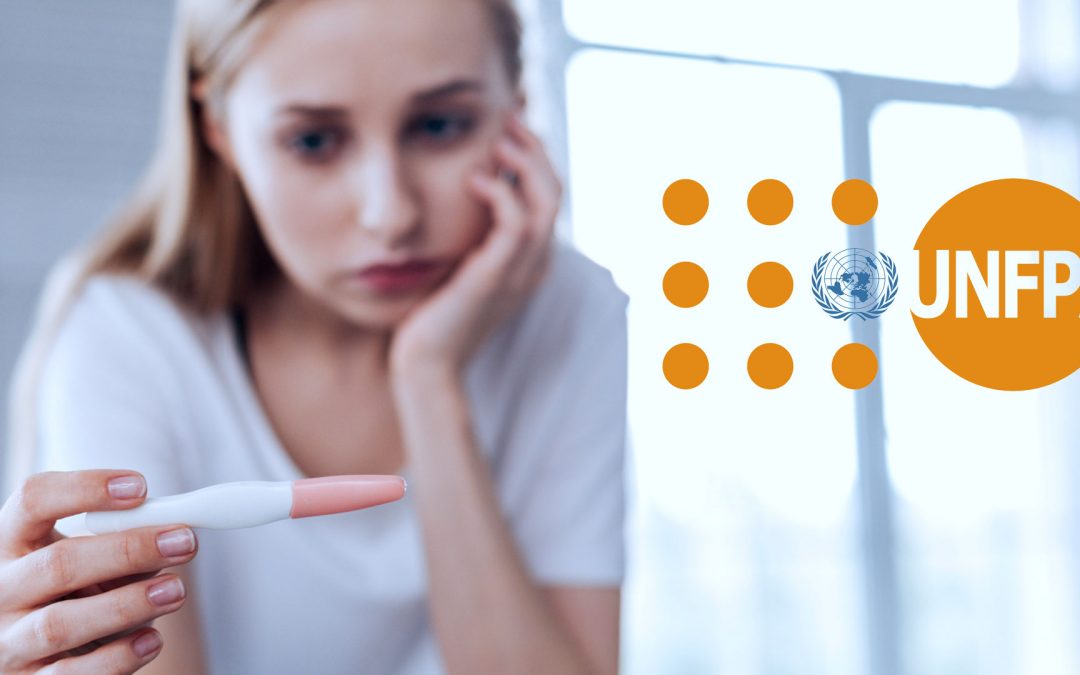
by Claire Anne Brule | April 29, 2022 | Abortion, Maternity, Publications, Reports
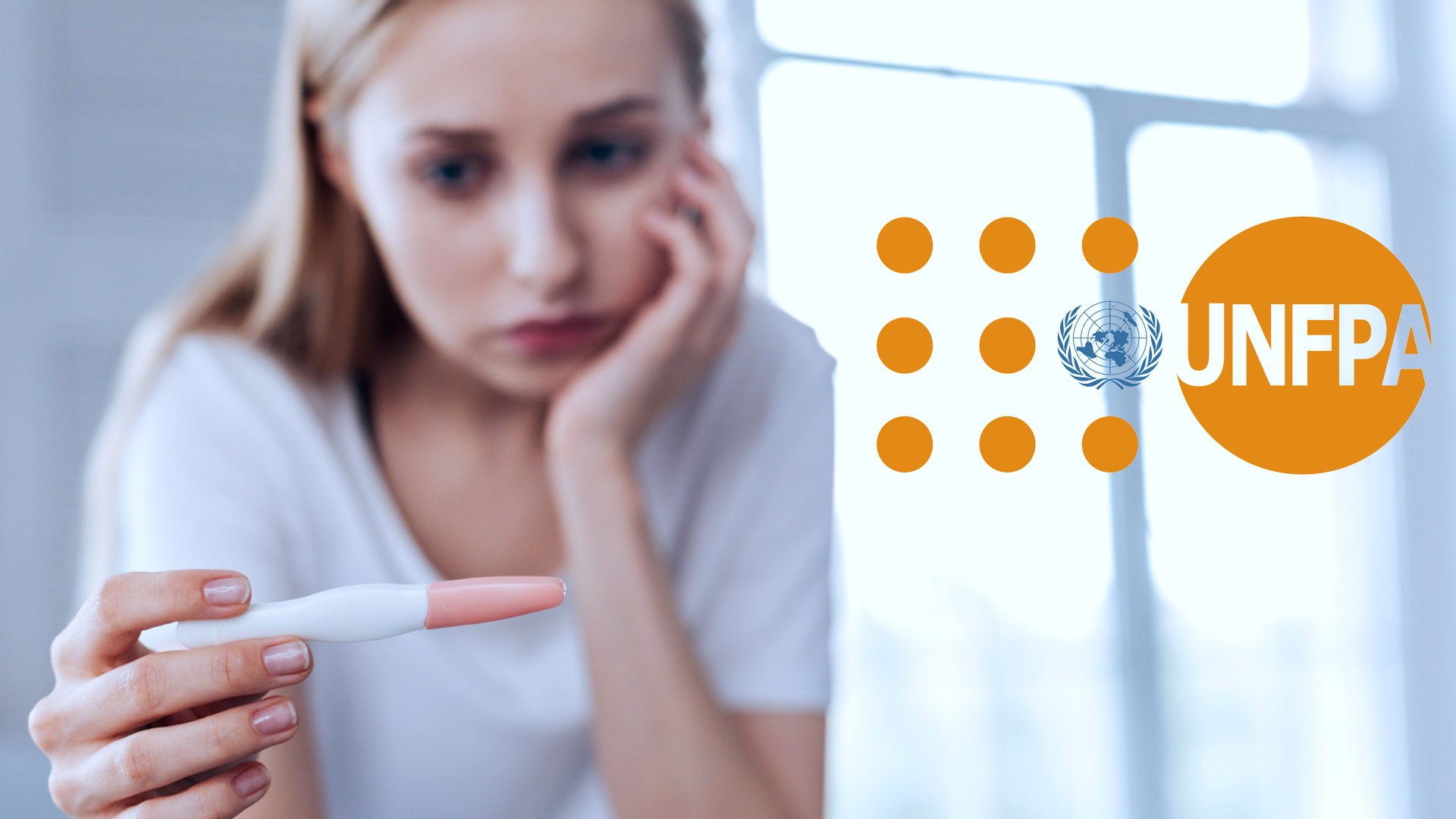
Analysis – April 2022
The UNFPA (United Nations Population Fund) report “Seeing the Unseen: The case for action in the neglected crisis of unintended pregnancy,” purports to:
- describe the extent of “unintended pregnancies” throughout the world
- discuss the socio-economic and health consequences for women,
- offer recommendations for reducing the number of unintended pregnancies.
In this analysis, we discuss the scientific reliability, limitations, and drawbacks of the WHO’s approach for evaluating this topic.
- Analyzing the numbers of unintended pregnancies worldwide
This latest report states that every year, almost half of all pregnancies worldwide are unintended: “this is the percentage of pregnancies that do not result from a deliberate choice on the part of women and girls in the world”.
The asserted number of 50% of all unintended pregnancies originates from the 48% projected by The Lancet Global Health Journal [1] in July 2020 on pregnancies and abortion worldwide and by region. This figure for an overall global average is inferred from using an average estimate of 121 million unintended pregnancies in a range varying 112.8 to 131.5 million with a low uncertainty interval of 80%. This dubious estimate corresponds to a global annual rate of 64 unintended pregnancies per 1000 women of childbearing age (estimate between 60 and 70 with an uncertainty interval of 80%).
The UNFPA report is based on another study published by the same authors in 2022 in the British Medical Journal (BMJ). It gives a detailed analysis of 150 countries and gives estimates on the incidence of unwanted pregnancies and abortions [2]. Upon close examination, it is noteworthy that the uncertainty intervals can vary quite significantly between different countries. Even when focusing on European and North American countries, we can observe particularly wide ranges in the data. In France, for example, the annual rate of unintended pregnancies per 1000 women is estimated to be between 26 – 34 whereas in Romania it is between 31 – 70 and in Russia between 48 – 90 (with an 80% uncertainty interval).
Moreover, the divergences are much greater in other parts of the world.
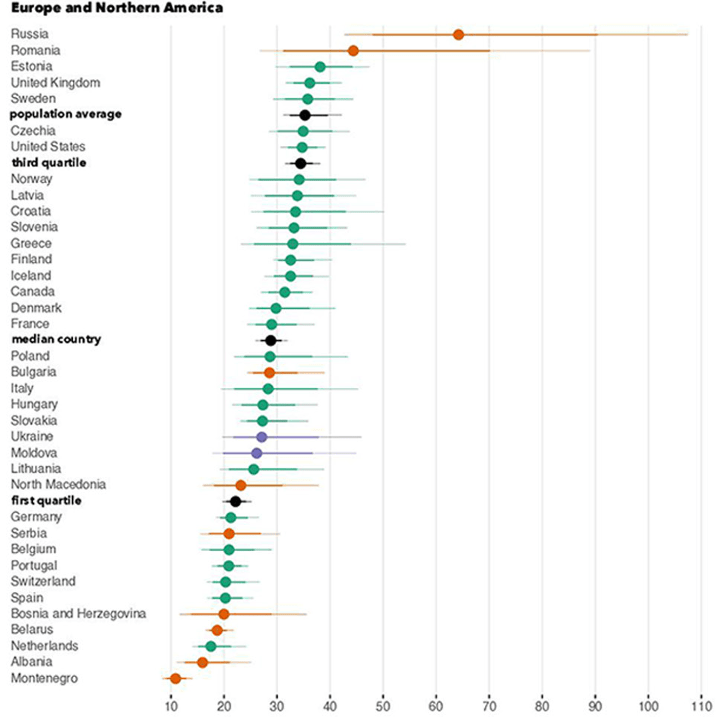
Ranking of European and North American countries according to the rate of unintended pregnancies per 1000 women of childbearing age (from [2])
In addition to the question of how these estimates are calculated, some countries are not even included in the BMJ study [2] nor in the UNFPA report. Subsequently, this means data is lacking for all the North African countries (Algeria, Tunisia, Morocco, Libya, Egypt …) and the Arabian Peninsula (Saudi Arabia, Qatar, Yemen…). Nonetheless, in these regions referred to as Western Asia and North Africa, the authors estimated the rate of unintended pregnancies [1] to be between 67 and 114/1000 which means a difference of 47. This region is thereby attributed to having the largest worldwide difference: compared to 10 in sub-Saharan Africa, 11 in Central and Southern Asia, 25 in Eastern and Southeastern Asia, 18 in Latin America, 6 in Europe and North America, 13 in Australia and New Zealand. Finally, the UNFPA report does not provide estimates for 55 out of the total of 203 countries and territories. Consequently, given the lack of reliable data, the claim asserting that half of the world’s pregnancies are unintended is difficult to consider as being factual.
- Qualitative analysis on the concept of unintended pregnancy
Bias n°1: The limitations of the classification used
According to the report, “Most current estimates of the incidence of unintended pregnancies are derived from questions used in population-based surveys, such as Demographic and Health Surveys (DHS) in low-income countries. The DHS asks women a single question about each pregnancy that occurred, up to five years in the past. It is usually a version of: “At the time you became pregnant, did you want to become pregnant then, did you want to wait until later, or did you not want to have any (more) children at all? “Women who respond that they did not want to become pregnant or that they wanted to wait are automatically classified as unintended pregnancies.”
However, unintended pregnancies are composed of two very different situations:
- Unintended/unwanted pregnancies for women who do not want or no longer want to have children.
- Unexpected/unplanned pregnancies occurring in a woman’s life before what she had planned.
In the report, no distinction is made between these two types of pregnancy.
Nonetheless the report quotes a distinction made between these two categories in the 2014 study by Moreau et al [3]: “in a large survey conducted in France, respondents were more likely to say a pregnancy was “unplanned” than they were to report it was “unwanted”.
This French study [3] is based on the 2010 FECOND survey of a cohort of 5272 women and 3373 men who were asked two questions: “Was this pregnancy desired” to classify unwanted pregnancies and “Was this pregnancy planned” to determine unexpected pregnancies. The results demonstrated that 53% of pregnancies were unexpected and 47% were unwanted. However, the meaning of unexpected is not the same as unwanted, when considering the intention
Unfortunately, this distinction for French data is not available for country by country throughout the world. This information could reveal very significant differences from one country to another. As it stands, the UNFPA’s current approach for evaluating the situation avoids a fine analysis of the situation of women and prevents adequate recommendations.
Bias n°2: Ambivalence needs to be considered
Another important bias stems from the ambivalence surrounding pregnancy which can make it difficult to clearly elucidate a woman’s intentions. The report states that “ Researchers have long noted, and struggled to precisely capture, how women’s attitudes toward getting pregnant can fall on a spectrum and is difficult to understand in all its complexity (Hall et al., 2017, Aiken et al., 2016). Thus, many women feel a certain ambivalence at the prospect of starting or expanding a family. Some want to have a baby, but have doubts about their life circumstances, partner or future. A woman’s desire for pregnancy may ebb and flow before, and during, a pregnancy. Moreover, the very notion of intentionality is often problematic (…).”
The authors admit that these situations are difficult to analyze. “This uncertainty has an impact on the data. Many metrics assume that women make conscious and binary decisions about whether or not they want to have a child. A dichotomous measure of pregnancy intentions may not fully capture individuals’ feelings about their pregnancies.” Even so, ambivalence is not considered when conducting surveys, and respondents are rarely offered the choice of admitting: “I am ambivalent about my pregnancy”. The more elaborate questionnaire used in some countries, the London Measure of Unplanned Pregnancy does contain many questions about ambivalence, but only prior to pregnancy. It uses the following expressions: “just before I became pregnant, I’m constantly changing my mind” or “I had mixed feelings about having a child”. However, no study has been carried out to better reflect women’s mixed feelings during pregnancy.
Finally, the data from surveys regarding ambivalence prior to pregnancy from the Lancet article [1] and the British Medical Journal [2] are recategorized from 3 categories of “planned”, “unplanned”, “ambivalent” into 2 categories of “unwanted” and “planned”.
It is difficult to measure intentionality without bearing in mind the role ambivalence plays in the complex decision-making process.
Moreover, in its recommendations, the report itself insists that new studies are needed and “will have to better expose the differences between “unintended” but “wanted” pregnancies, those which arouse ambivalent feelings, and those which are undesired, in order to fully understand the factors behind these pregnancies. »
Thus, there are 2 biases on the relevance of estimates for unintended pregnancies:
– the broad definition for the concept of unintended pregnancies,
– and the lack of a survey on women’s ambivalence before and especially during pregnancy, as well as failing to take this data into consideration when it is measured.
- Has a proven causal link been established between abortion legislation and the rate of unintended pregnancies?
The UNFPA report states that “Rates of unintended pregnancies tend to be lower in countries with liberal abortion laws (i.e., where abortion is allowed for socio-economic reasons or upon request) compared to countries with more restrictive legislation.”
In spite of this assertion, the authors add: “Although this correlation is indisputable, no causal link could be established. Indeed, having favorable abortion laws does not seem to have an effect on the incidence of unintended pregnancies.”
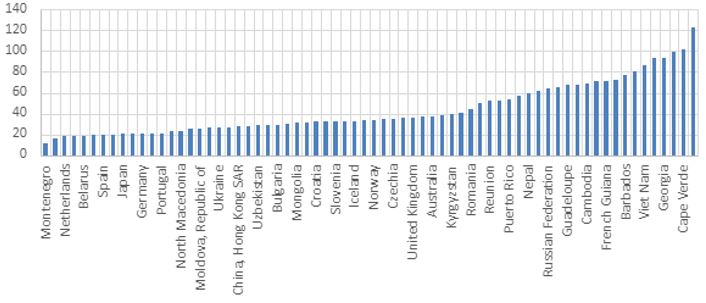
Total rate of unintended pregnancies in countries where abortion is broadly legal
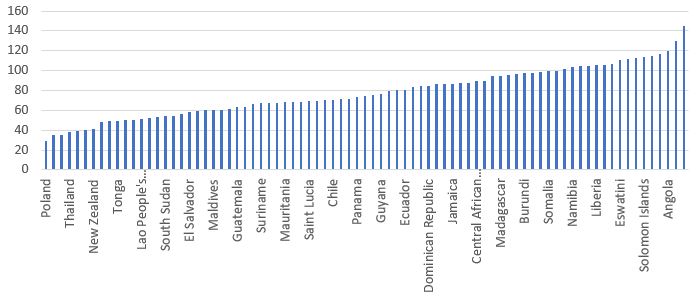
Total rate of unintended pregnancies in countries where abortion is restricted
Although the total overall rate of unintended pregnancies may be lower in countries where abortion is legal, (58 versus 73/1000), this can conceal large differences from one country to another. Indeed, the individual rates for unintended pregnancies range from 11 to123 in countries where abortion is legal, and from 29 to 145 in countries with restricted access to abortion.
- Conspicuously, a country’s category for abortion laws is not predictive of its’ rate of unintended pregnancy. In an example with two European countries, the unintended pregnancy rate is 36 in the UK where abortion is legal, while Poland with more restricted abortion laws has a lower rate of 29.
- Is there a link between the prevalence of contraceptive use and unintended pregnancies?
The UNFPA report recommends that modern contraception must be made more widely available to reduce the number of unintended pregnancies. Remarkably, and without providing a reference, the authors estimate that 257 million women who do not wish to become pregnant are not using safe and modern contraceptives such as condoms, pills or IUDs.
Nevertheless, the rate of unintended pregnancies is weakly correlated with the prevalence of contraceptive use. Scatter plots graphing the relationship between two quantitative values illustrate this poor correlation, concomitant with its’ very low correlation coefficient of R²=0.13:
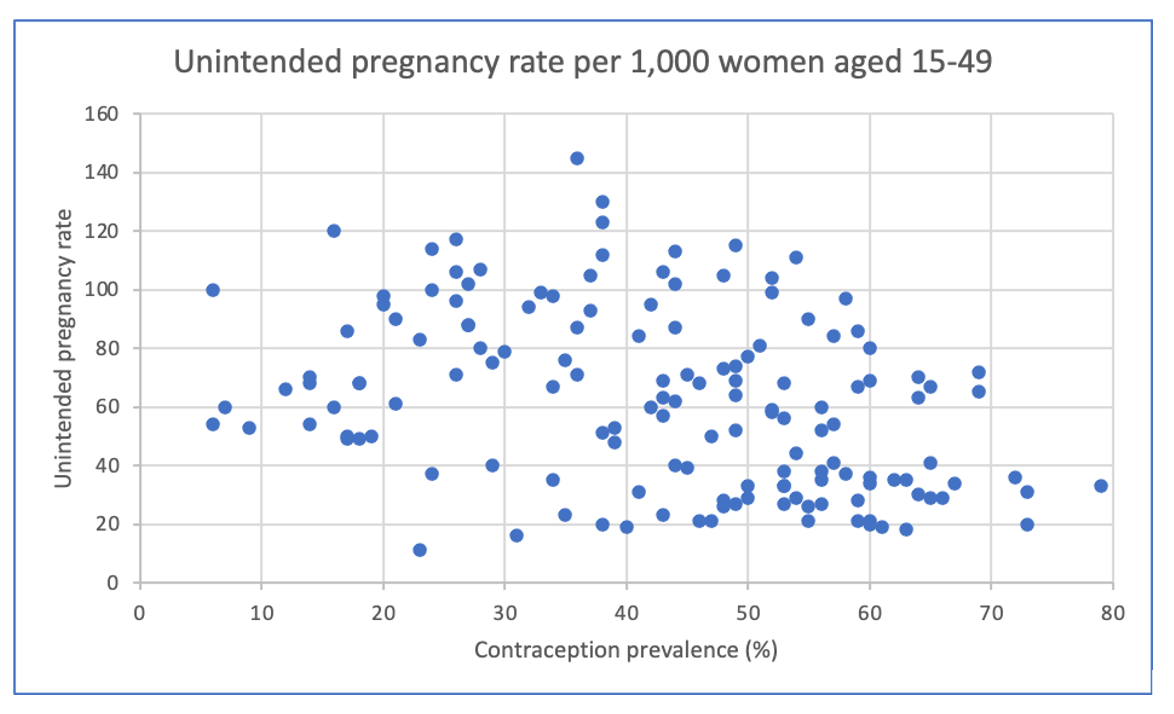
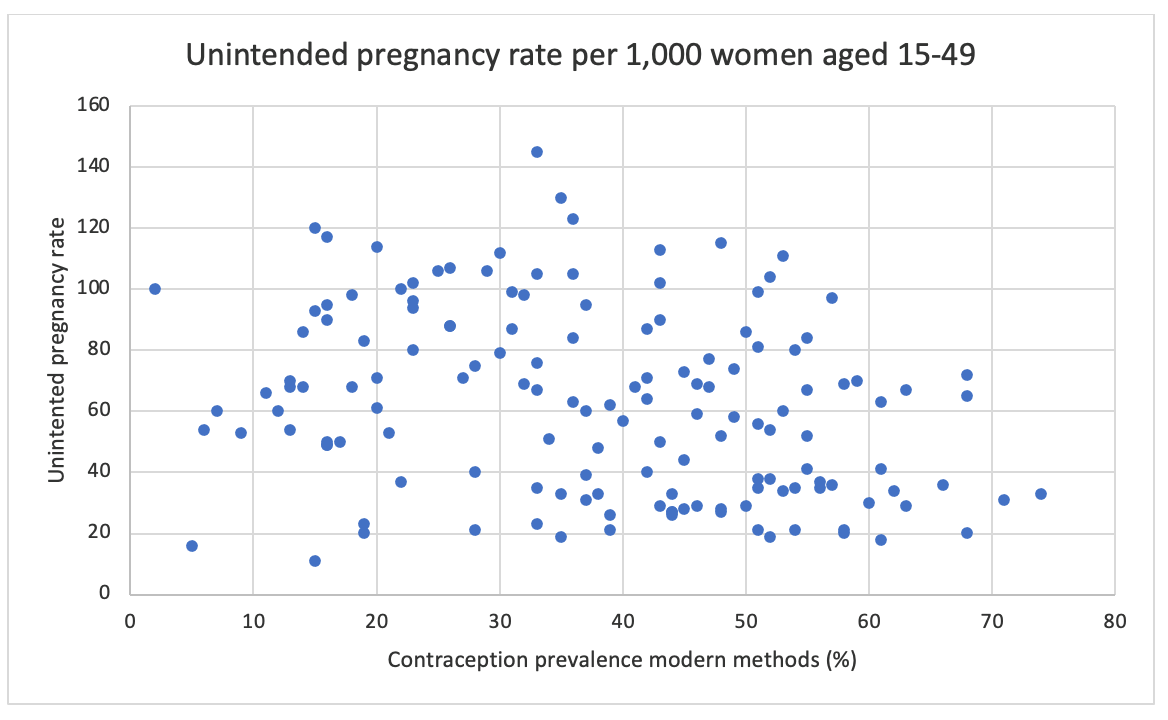
Based on the statistical low correlation between these variables, the multiple and repeated UNFPA recommendations for further extending contraceptive use to reduce unintended pregnancies appear to be unsubstantiated.
Furthermore, the data show that the prevalence of modern contraception methods has a slightly lower correlation coefficient than that of using contraception methods of any type (0.08 versus 0.13 respectively).
Finally, basing their claim on the reference article [6], the report asserts there is an urgent need for access to modern contraception, since in 47 developing countries, 41% of sexually active women do not use any method of contraception. Upon closer analysis of the publication mentioned, it is specifically stipulated that the two main reasons for not using modern contraception in these countries are: “the health risk” and “the low frequency of sexual intercourse” far ahead of the “lack of access”.
For example:
- 30% of the Indonesian women surveyed mentioned the health risk, 22% mentioned the low frequency of sexual intercourse and only 4% mentioned lack of access.
- 36% of the Cambodian women surveyed mentioned “health risk”, 46% mentioned low frequency of sexual intercourse, and a mere 3% mentioned lack of access.
As a conclusion, extending the availability of modern contraceptives cannot be the unique solution for reducing unintended pregnancies.
Scientific Bibliography
[1] Unintended pregnancy and abortion by income, region, and the legal status of abortion: estimates from a comprehensive model for 1990-2019, Guttmacher Institute, WHO, University of Massachusetts, July 2020, The Lancet Global Health Journal https://www.thelancet.com/journals/langlo/article/PIIS2214-109X(20)30315-6/fulltext
[2] Bearak, Jonathan and others, 2022. “Country-Specific Estimates of Unintended Pregnancy and Abortion Incidence: A Global Comparative Analysis of Levels in 2015–2019.” British Medical Journal Global Health, https://gh.bmj.com/content/7/3/e007151
[3] Moreau, Caroline and others, 2014. “Unplanned or Unwanted? A Randomized Study of National Estimates of Pregnancy Intentions.” Fertility and Sterility 102(6): 1663–1670. https://www.fertstert.org/article/S0015-0282(14)02070-6/fulltext
[4] The Misclassification of Ambivalence in Pregnancy Intentions: A Mixed-Methods Analysis AM Gómez, S Arteaga, E Villaseñor, J Arcara, and B Freihart, Perspect Sex Reprod Health. 2019 March ; 51(1): 7–15. doi:10.1363/psrh.12088 https://www.ncbi.nlm.nih.gov/pmc/articles/PMC6476569/pdf/nihms-1013515.pdf
[5] Miscarriage matters: the epidemiological, physical, psychological, and economic costs of early pregnancy loss. https://www.thelancet.com/pdfs/journals/lancet/PIIS0140-6736(21)00682-6.pdf
[6] Moreira, L.R., Ewerling, F., Barros, A.J.D. et al. Reasons for nonuse of contraceptive methods by women with demand for contraception not satisfied: an assessment of low and middle-income countries using demographic and health surveys. Reprod Health 16, 148 (2019). https://reproductive-health-journal.biomedcentral.com/articles/10.1186/s12978-019-0805-7#:~:text=On%20average%2C%20%E2%80%9Chealth%20concern%E2%80%9D,with%20higher%20demand%20not%20satisfied.















